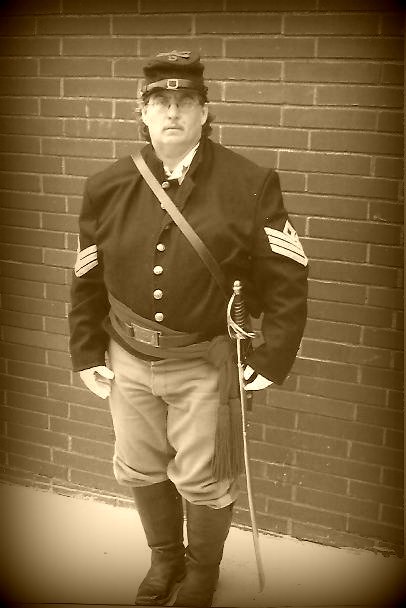
2010

Part of the 3rd Iowa Cavalry Reenactors Inc., mission is to honor the Women Soldiers, who served and died in the Civil War. The woman soldier is a fold in history and the public today are unaware of those women. At events, I've asked the question, "How many women were soldiers in the Civil War." I usually get a blank stare or they say none. The poem below asks who would remember me?

Once I stood in the ranks of Blue.
Once I stood in the ranks of Gray.
Fighting for a cause so true
Wondering-who would remember me today?
Disguised as a man; filled with alarm.
An enemy's bullet could yet slay
This woman's life-or cause me harm.
Who would remember me today?
The missiles, they whistle through the air.
A "rebel yell" from those in gray.
The victor's shout, the loser's despair.
Who would remember me today?
A last volley sent from hidden lines,
Of sudden shock! Life fades away.
Crimson springs from this body mine.
Pray-Who would remember me today?
Please lay me in grave, unmarked
And place me where my comrades lay.
Remember this battle with a park
And please, remember me today.
In 2006, I began my journey as a time traveler and became a Civil War woman soldier. I've tried to honor the woman soldier by educating the public and by doing my best to blend in with the boys.
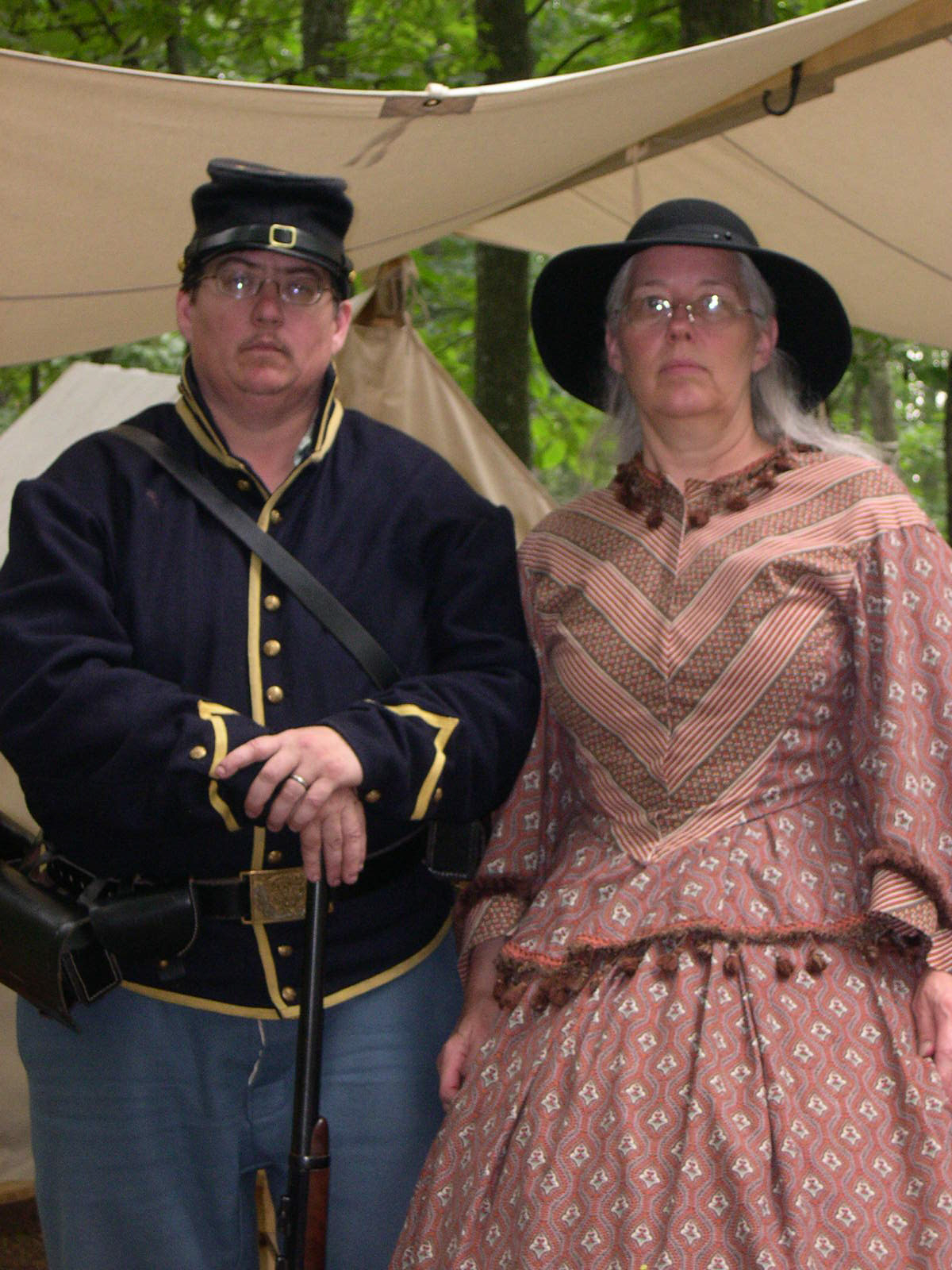

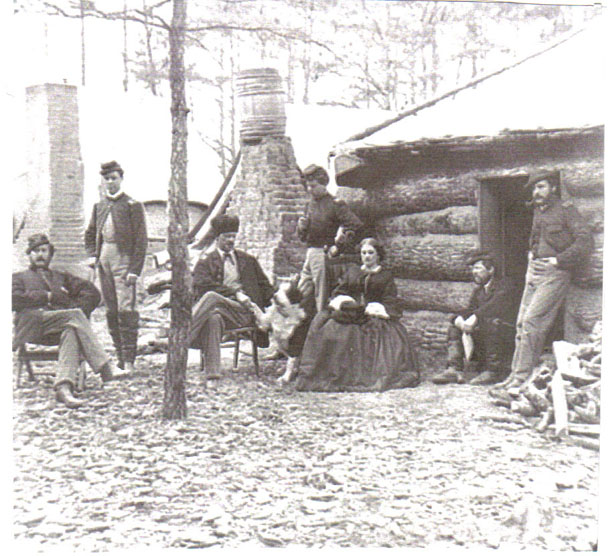
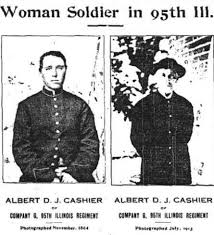
Lady Soldier is in the photo-which one is she? Sarah Rosetta Wakeman
Does the question below, echo in your mind?
Who would remember them?
And you've answered, "I will."
Contact me, CK Baker, AKA Kathy Kroeger, at
bkroeger@fbcom.net, and as you start your journey, we ask of you, to
research, research and research. Get to know the women who were
soldiers. We will help you grow in your role as a women soldier. Below
are the guidelines adopted by the organization for anyone wanting to be
a woman soldier. I chose the ladies below because they are at the top of the class for blending in with the boys. Look at other photos and sees if ya can find the others-sticking out from under cap or a pony tail.
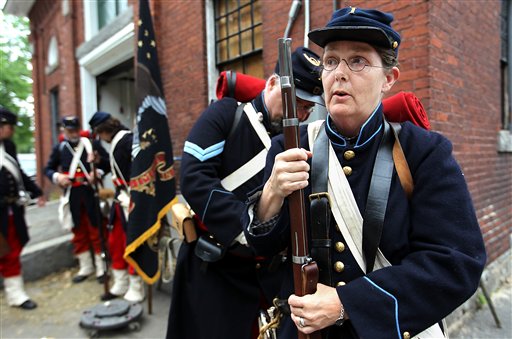


Elizabeth Charlton Wendy A. King CSA Joyce Henry-Lt Harry Buford
If ya watch "God & Generals" Look for Wendy, she is in the movie-loading a wagon


Bard Duder-Hospital Steward Tracey McIntire and Audrey Scanlan-Teller Jessica Fink

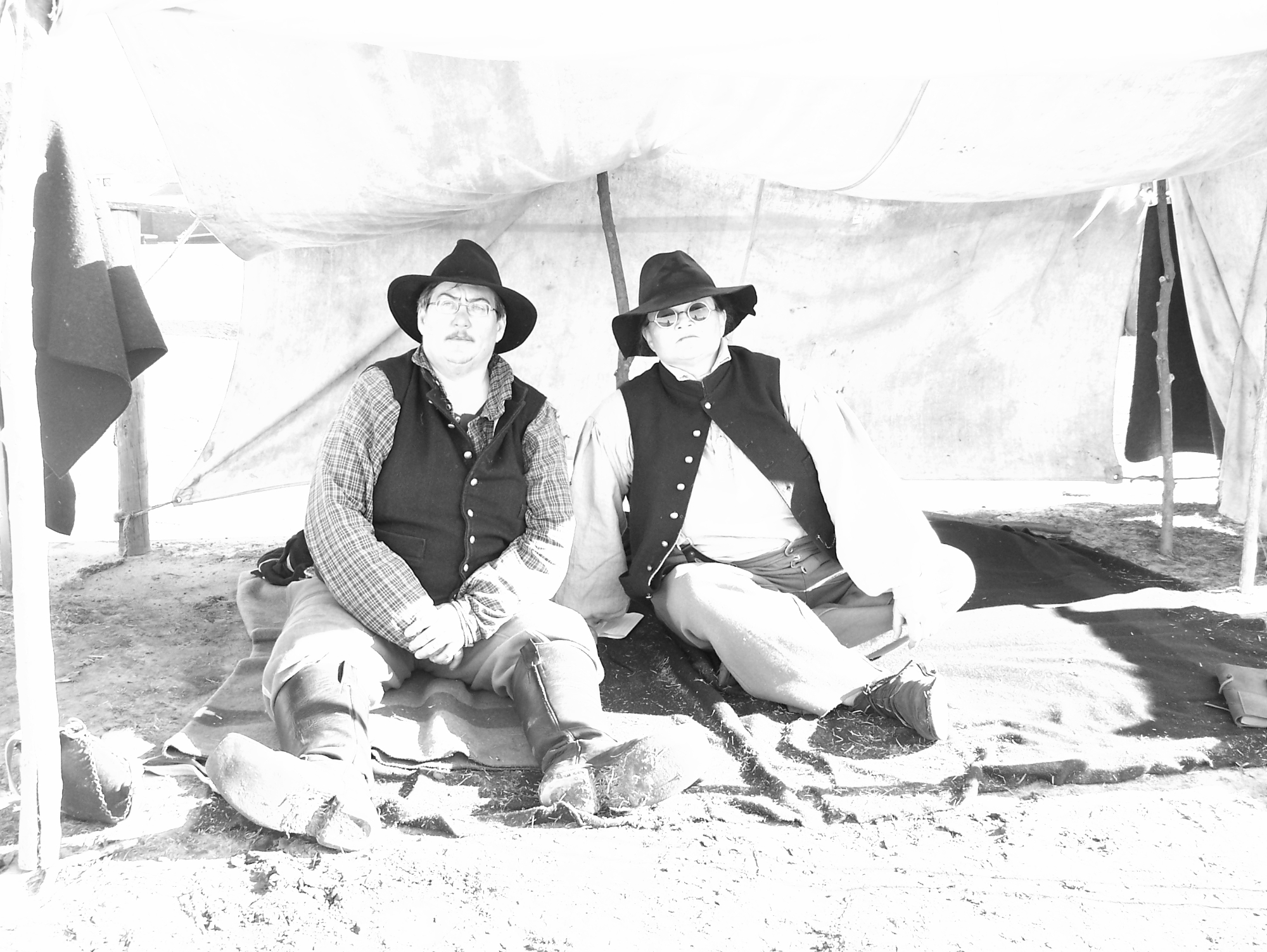
Lets begin with the Recommended Guidelines
WOMEN IN UNIFORM AS
CIVIL WAR SOLDIERS
Recommended Guidelines
By Wendy A. King
Published here with her permission
With more and more women entering the Civil War re-enactment community as soldiers: some with very good impressions and some with terrible impressions, it seems logical to have a set of standards to follow. This would help both the sponsors of the event(s) and the women who wish to portray soldiers to have certain common ideas in mind as to authenticity and what should be expected of any given individual. It is with the idea of common goals and defining what exactly is desired of those women who portray soldiers that this is written.
Uniform
A) Basic Uniform: Same as men's, including accouterments and brogans. The vest, jacket, and trousers should be one size larger than normal to hide obvious female characteristics.
B) Binder: An absolute must unless you are completely flat chested. Sports brassieres do not give the kind of support or effect that is desirable. One can still detect "unmanly" chest movement and those type brassieres don't really protect you from pain or your fellow soldiers from possible embarrassment. Imagine that you are in a tactical and a branch snaps you across the chest. Will a "Sports Brassiere" protect the tender areas? The answer is no. Now imagine that you take a "hit" face up and the hospital corps comes to check for a heart beat. Will that Sports Brassiere keep them from finding out your true gender and save both the corps soldiers and yourself from embarrassment? Again, the answer is no.
The importance of a good binder
a. Protects you and your comrades from embarrassment.
b. Keeps your gender a secret.
c. Protects other soldiers from embarrassment
d. It is authentic. Original women soldiers wore binders.
Binder pattern
Read instructions carefully!
Materials: Plain Cotton, Muslin, *Linen or sheeting material , (amount described in instructions) Shoulder strap material, (any material that is either strong enough on its own not to break under stress, or that can be doubled without too much bulk and will hold up under stress - amount described in instructions) Hooks and Eyes, Bra extenders preferably with a double set of eyes, (3-4, depending on how wide they are, the wider and more hooks and eyes they have, the less fuss when changing the garment) Two brassiere guides or belt slides, (like on the backs of vests) Thread.
Measuring for amount of material:
Measuring for amount of material:
1.) One piece 21" wide x chest at breast attachment + 1" See Instructions 2 - 3.
2.) Measure chest at base of breast attachment



3.) Add 2" to total, this gives you the total length of material you will need.
4.) Fold material in half width-wise so that you have 10-1/2" x breast attachment.
5.) Using 1/2' seam, sew material together at two raw edges, turn inside out, fold remaining raw edge inside itself and topstitch a seam.

6.) Using bra extenders as a guide, mark eye locations on edge of what you want to be the left side. Insert the hub of the eyes into the seam area and hand stitch using heavy thread.
7.) On right side, measure in 3-1/2" from edge and mark a line from top to bottom. This line is your marker for the hooks. Fold about 1/2' of material from the main body of the binder over and back on itself (both thicknesses) so that your line falls just where the bases of the hooks attach.


8.) Using bra extenders as a guide, mark hook locations. Insert the hub of the hooks into the hook line and hand stitch using heavy thread. Keeping the area folded as above, sew a seam down and through each of the hook hubs.

*** The 3-1/2' flap protects the back from hook gouging!
9.) Measure shoulder strap from regular brassiere. Use this measurement for binder shoulder straps, adding 2' to each strap. Cut the 2' extra from each strap and use to loop guides or belt slides to front (X ) on diagram. Fasten remaining lengths at back (Y)


Leave a one-inch space between the hooks seam and the right back. Leave an eight-inch gap between all back and front straps. Leave a five inch gap from the left (eyes) edge and the left back strap.
10.) Hook bra extenders to one side (obviously, it doesn't matter which side!). When you are ready to put the garment on, you just have to hook one side.
** OPTIONAL 11.) You may want to cut out a semi-circle from the binder just below the underarm to reduce pinching. Just cut the necessary area, turn the raw edges to the inside, and top stitch.
C) Hair: Cut short, or in such a way that the short back underlengths of hair [preferably emulating the bottom parts of a man's hair cut] may be let down while longer upper lengths are pulled well up. Longer hair should be kept hidden during hours when camp is open to the public and during battle.

Any other circumstances should be discussed with your unit commander.
(I.e. dances, that is if you are permitted to change gender for such occasions)
This does not apply in emergency situations such as heat related problems when you need to get as cool as possible.
D) Headgear: Forage and Bummer caps are greatly preferred over "slouch" hats and Kepis. "Slouch" hats have wide brims and tend to "frame" the face, causing female traits to be emphasized. Kepis should be avoided, especially if one decides to wear longer hair, pulled up. Kepis just aren't long enough in the back to hide the pulled up appearance.
E) Vest: One size larger than normal. Should be worn anytime that a jacket is not being worn. Not only for authenticity sake, (technically the men should also be wearing them) but to help hide any female features. The only time a vest or jacket should not be worn is in case of heat emergency or in the privacy of your own tent.
F) Dresses: Permitted at the discretion of your unit commander and depending on circumstance. (Dances, Dinners, Special Occasions) Unless specific instructions are given by the host of that event that being in uniform at all times is an absolute requirement.
G) Conduct:
1) Guard duty, Picket duty, Drill, Camp chores, Parades: NEVER REFUSE to do your duty or detail as a soldier without very good reason AND permission from your commanding officer. Being a female DOES NOT excuse you from any of the tasks performed by your fellow soldiers. By performing the same work, duty,and drills as your male counterparts, you gain their respect. Failure to do your part can result in being pointed out as a poor example of a female soldier and can make it harder for the next woman who wants to portray a soldier.
Remember! You are setting the standard. Poor examples are more easily discovered than good ones!
2) Discretion: While in the field or in camp, you may face situations that require mature handling. PLEASE use your head and think before you say or do anything that may embarrass your comrades or yourself If you find yourself, for example, in lines of men who need to give in to "the call of nature", Don't make a big deal about it! Either turn your head, close your eyes, or ask someone from your own unit to let you know when it is "safe". Most of those soldiers out there don't know that you are a woman and are only thinking of one thing. RELIEF!! Respect their privacy and you will be respected.
Another situation that may arise may be that, while you are wearing your proper binder and decide to take a "hit", someone may come to check you for a heart beat. They also do not know your true gender. If you are "dead" - stay dead. Don't make a fuss about checking your chest unless some surgeon unknowingly chooses you for an un-scripted chest wound scenario. In that case, quietly let him know why he can't use you!
For The Men
Should you ever feel the need to "heed the call of nature", especially out on the lines; please don't feel embarrassed if you find out that a female is or was present. We are not there to be an embarrassment. We are there, just as you are, to re-enact a segment of history that we too are a part of. There were indeed women who fielded as soldiers during the American Civil War, and they have earned the same right to be represented as any other soldier does. (In the proper manner, which includes maturity in any given circumstance)
Another important matter is: Please don't be so quick to remove the cap from your neighbors head when "taps" is being played, you may end up with a shock when that guy you've just been wrestling with in hand - to - hand combat turns out to be - - a gal!! (You could remind the soldier that "taps" is being played - most women soldiers can come up with some type of period excuse - head wound, cold, etc. - a man will usually take the hint and remove his cap)
DISGUISE HINTS
1) Fake mustaches, beards, and wigs: Any of these are acceptable if they are not too "fakey". Keep in mind though that it can get very hot and most of the heat in a human body collects at the head. Wigs are not recommended (especially for infantry) since you will be wearing headgear (Kepi's or bummer caps) and it will make you twice as hot and twice as likely to go down from heat. Finding a good adhesive for mustaches and beards can be difficult since you need one that is both waterproof and sweat proof. The closest thing available is the liquid eyelash adhesive (for individual lashes). Even Spirit Gum (used by professional actors) is not waterproof. (They get to yell "cut" and have things replaced in the middle of a shot, we don't!!)
2) Camouflage Paint: Don't rely on regular make-up to darken your skin, you'll sweat it right off. Camouflage paint is oil based, readily available in most stores with sporting goods, and is inexpensive.
3) Voice: One of the most difficult things to disguise. Try to keep your voice tone low and deep. If that is impossible, try not to speak too often when you do find it necessary to speak. ( NCO's : Yelling orders in battle doesn't count because everyone else is yelling and their voices are cracking too!)
4) EXERCISE !!: Strange as this may seem, you will be marching, (for cavalry: riding) sometimes for miles, over various terrain and weather conditions; and that you will be carrying a 10 - 12 pound rifle, accouterments, food, water, and wearing a wool uniform and brogans. Lifting weights,walking, hiking, doing upper and lower body exercises and doing back strengthening exercises can help you endure the parades, marches, drills, tacticals, and battles without "wimping out".
5) Study,
study, study: Study
your history, study the way that men walk, stand, sit and move and try to copy
them. Learn about the women who did fight as soldiers so that you can
talk with assurance about the fact that they did fight. Find a name and a
background for yourself as a soldier (real or otherwise) and encourage your
fellow soldiers to use it whenever you are in uniform.
Other Important Notes
Some of the anachronisms most often brought to my attention when women are on the battlefield, and often noticed by my fellow soldiers, are things that common sense should say DON'T belong there.
Yet, as often as these mistakes occur, it seems that common sense doesn't apply.
ABSOLUTE NO NO's
for female soldiers:
No "normal" female make-up including:
eye shadow
blush
rouge
eye liner
lip stick
No recognizable female jewelry including:
earrings
bracelets
wrist watches
modern rings
necklaces
modern eyeglasses
NO LONG NAILS
NO PAINTED NAILS
Let's face it. If you want to get out and "play" with "the boys", you should look and act like one of "the boys". Save the "female stuff" for when it appropriate --- and the battlefield is definitely NOT appropriate.
Note: the sketches did not come over when you get ready to make the binder, ask Kathy for a paper copy of guidelines.

The Third Iowa Cavalry Volunteer Regiment, may have had a woman or 2 in its ranks. A lot of research has been done on one, several stories exist and nothing has been found to clear up who she really is. E.J. Guerin, per her autobiography was born 1831, Baton Rouge, LA. A woman named Charlotte Hatfield, per several authors was born 1841 in Iowa, both known as Mountain Charley. I've done research on the two and feel they are two different women.
Richard Hall author of "Women on the Battlefield" states within his book the evidence points to her being in the 3rd Iowa Cavalry at the battle of Westport MO, 1864, who was wounded and captured by the rebs and the rebel surgeon kept her secret as did the Union surgeon she was turned over to. Another author Egglestone, also stated within his book that Charlotte Hatfield may have been in the Third Iowa Cavalry.
There is said to be a diary written during her civil war days and given to George West, Editor and founder of the Golden Transcript, friend from the Colorado gold fields before the civil war and fellow soldier-George, a Capt with the 2nd Colorado and who was at Westport, MO, in 1864, they were part of the Union army in the pursuit of CSA General Price.
There is a letter within the information I researched, with the Iowa town and county not shown, written to West by Hatfield in 8 Feb 1885, letting him know she had seen his newspaper an the story written about her.The counties in Iowa starting with M; and have a town starting with G. Are Glenwood, Mills Co, Georgetown, Monroe County and Green Mountain, Marshall County.
A mystery is a foot and the search is on.